Review: Airfix 1/48 Hurricane I
First appearing in 1935, the Hawker Hurricane was the first modern monoplane fighter to equip the RAF, and was one of only three RAF aircraft to operate in first-line service from the first day of the Second World War to the last. (The other two being the Spitfire and the Swordfish)
Though the Spitfire gained the glory in the Battle of Britain, it was the tough Hurricane that won the fight. Three-fifths of the squadrons of RAF's Fighter Command were mounted on Sidney Camm's fighter that summer of 1940. Though outperformed by the Bf-109E, the Hurricane had the benefit of being "primitive" enough in its construction that shot down Hurricanes could be quickly repaired and returned to service, which was the RAF "secret" that really won the Battle of Britain - fully 60 percent of the Hurricanes shot down over England that summer were repaired and returned to operational use during the battle, a fact that Goering's Luftwaffe intelligence department missed as they confidently predicted that on September 15, 1940, there would be no RAF fighters over London. It was a scandal when reports came out that production Hurricane I's could barely make 305 mph at 10,000 feet - the height at which most combat occurred - and that the airplane could not be flown over 20,000 feet, the altitude from which the Messerschmitts dove out of the sun on their targets.
Outclassed or not, the Hurricane was there when it was needed, in numbers sufficient to change the outcome of a battle nearly everyone expected Britain to lose. As such, it is a model deserving of a place of high distinction in any collection.
Douglas Bader:
There is likely no pilot who flew in the Battle of Britain 75 years ago more famous than Douglas R.S. Bader, "the legless ace." He may even be the most famous British pilot, ever. I first ran across his story when I found Paul Brickhill's biography "Reach for the Sky" in the local library when I was around 11. The book was hugely successful, selling 100,000 copies on publication in Britain in 1952 and being made into a movie starring Kenneth More two years later, which finally made it to the States in 1957 - I of course was the only person in the theater watching it the opening day in Denver. Reading Bader's story at a young age, one cannot help but be inspired. Over the years, as I read more about him, he emerged a far more nuanced character than Brickhill had painted, full of the darker shades of gray, but still an inspiring individual. In 1977, a member of 242 Squadron who I met at that year's Abbotsford Air Show told me that "Bader could be arrogant, selfish and appallingly rude. He could be horrid to those under him and was thoroughly disliked by many of us." Yet this pilot also considered Bader one of the most outstanding individuals he ever met, and an inspirational leader.
In 1981, the year before his fatal heart attack, his niece Virginia Bader - who ran an aviation art gallery in Long Beach back then - presented a forum with Bader, his acolyte Johnny Johnson, and Robert R. Stanford-Tuck. Who could resist the opportunity of meeting them, even at an entry price of $50 per person? And there I discovered that what one could call the darker side of Douglas Bader was the dominant side, as he went out of his way to antagonize people who had come there to praise him. I had the opportunity to speak personally with Stanford-Tuck, whose comment in response to my comment about Bader was "That's Douglas. Like it or lump it, he'll never change."
And yet, despite all that, Bader is remembered by those who flew with him as a man who could inspire them to achieve feats they would not have thought themselves capable of, even as he managed to permanently antagonize many of them in the process. One can look at the names of the pilots who flew with him in 242 Squadron, and in the famous "Tangmere Wing," and find many who went on to great achievement as a result of what they had learned from him. This is nowhere more obvious than in the career of British ace-of-aces Johnny Johnson, who made it clear in his autobiography "Wing Leader" that he owed everything he later achieved in the war to what he learned from his close relationship with Bader at the outset of his career.
There is now a second biography of Bader, "Bader's War: Have A Go At Everything," by the superb British war historian S.P. Mackenzie, that reveals why and how Douglas Bader became the man he was.
It is often said that if one wants to understand the man, they need to understand the child he was. This is certainly true with Bader, whose childhood can only be called "harsh and unhappy." In such a forge would be created the uncompromising character of iron will and determination that would carry him through life.
Born February 21, 1910, Bader spent his first two years living with relatives on the Isle of Man while his parents returned to India. Reunited with them, he discovered his mother had never wanted him; she always took the side of his older brother, who delighted in tormenting Douglas, once shooting him in the shoulder with an air gun. The family returned to England in 1914 and in 1915, his father went off to war, the last Douglas ever saw of him, since he died of wounds two years later. Raised by an ineffectual Yorkshire clergyman as a step-father, Bader became an aggressive fighter in response to his brother's treatment. Once, at St. Edward's, his public school in Oxford, he got into a fight with future film star Laurence Olivier, who beat him up after being bowled out by Bader in a cricket match.
By the time he graduated, his central elements were obvious to all: the urge to compete and win at all costs, the desire to lead, a blustery self-confidence hiding his loneliness, and an undying need to prove himself.
He had not planned to join the RAF, and did so more out a lack of other opportunities and interests than anything else, though he discovered he had a knack for it once he was in. In November 1931 came the event that would define his life, when a group of pilots at a local aero club chided him about the performance of his Bristol Bulldog fighter. He tried to perform an aerobatic roll on takeoff, at an altitude of less than 20 feet. Misjudging height and speed, he dug a wingtip and cartwheeled into a terrible crash.
Only the early arrival of a rescuer prevented Bader bleeding to death right then. His luck held when he arrived in the hospital just in time to be treated by one of the best surgeons in England, who had been about to go home for the day. Bader lost his right leg above the knee that day and his left below the knee the next. Sedated for weeks, his first memory after the crash was hearing a Nursing Sister outside his hospital door say to another, "Be quiet, there's a boy dying in there."
In those days, there was nothing remotely like the kind of technology and treatment for amputees that exists today, but Bader applied himself like no one else, and within a year he had regained the ability to move, or lurch, if not to actually walk. Mackenzie calls this recovery, "an unparalleled triumph of determination and willpower over physical adversity".
By 1933, Bader was back in the cockpit and had proven conclusively he could fly. RAF regulations were unbending and he was refused reinstatement. For the next five years he was relentless in pursuing his return, declaring he would never take no for an answer. "By God, I'll sit on their doorsteps until I get in," he vowed. With the Munich Crisis at hand in 1938, the Air Ministry finally decided to ignore the regulations. "Getting back into the RAF was a masterpiece of persistence," Bader wrote.
Returning as a Pilot Officer when his contemporaries were Squadron Leaders, Bader quickly made up for lost time. Assigned to 222 Squadron, based at Duxford and commanded by his old friend, Squadron Leader "Tubby" Mermagen, and mounted on Spitfires, Bader first tasted combat while on patrol near Dunkirk on June 1, 1940, when he shot down a Bf-109E. Claiming a total of five kills on this mission, he was given final credit for another Bf-110 damaged. On the basis of his performance over Dunkirk, Bader was posted to command 242 Squadron, based at RAF Coltishall, on June 28, 1940. 242 was the only Canadian unit in England, and had suffered heavy casualties in France. Initially, many in the squadron thought the assignment of a "cripple" as their squadron leader was the final insult. Bader lurched out to a Hurricane, climbed in, and gave a bravura low altitude air show performance, which ended all doubts of his ability. "People fell in behind him because he had the personality to run things," was how Johnny Johnson described him after first meeting Bader at Duxford that September in the midst of an invasion scare in which Bader was the only one looking forward to the event. Under his leadership, 242 was declared operational on July 9, 1940. Flying limited combat during the difficult period of the Battle of Britain in July and August from Coltishall, Bader still managed to score victories and to create such a good record that the squadron was assigned to Duxford on August 30.
Throughout the Battle of Britain, Bader thoroughly disagreed with the tactics advocated by Air Chief Marshal Hugh Dowding, OC Fighter Command, and used by Air Vice Marshal Keith Park, OC 11 Group, the "front line" unit facing the Luftwaffe. In this, Bader was joined by many of the "traditionalists" of the RAF, men such as Air Vice Marshal Sholto Douglas, who believed the RAF should engage the Luftwaffe in an all-out battle.
Dowding disagreed. For him, "victory" would come with the end of "invasion season," the time of year when the weather would prevent a cross-Channel invasion by the Wehrmacht for at least another year. It was Dowding's purpose to not loose too much of Fighter Command - pilots or airplanes - in any given combat, in order to keep "bleeding" the Luftwaffe and denying them the air superiority that was essential to the success of any invasion. For Dowding and Park, this meant holding on until the end of September, when winter came to the English Channel.
What was perhaps the most amazing part of Bader's career during the Battle of Britain was how a lowly Squadron Leader managed to get the ear of Air Vice Marshal Trafford Leigh-Mallory, the Air Officer Commanding 12 Group, to which 242 Squadron was assigned. It was apparently due to force of personality on the part of Bader, and the fact that Leigh-Mallory had no understanding of fighter warfare, having spent his career in Army Cooperation Command. Leigh-Mallory was also well-known as being vulnerable to flattery regarding his unseen-by-everyone-else intellectual abilities. (In 1944, Air Chief Marshal Tedder, second in command of SHAEF, threatened to resign if Eisenhower didn't get rid of Leigh-Mallory for incompetence in his role as commander of Allied tactical air forces in the invasion. The problem was solved by kicking Leigh-Mallory "upstairs" to take command of Air Defense of Great Britain, which by then was not the crucial command it had been four years previously, and was thought to be an assignment Leigh-Mallory would not screw up.)
Where 11 Group's assignment was to intercept the bombers before they unloaded, that of 12 Group - which was mostly out of range of the Luftwaffe at its bases in East Anglia and the Midlands - was to be the "back up" for 11 Group, with an important assignment to defend the airfields in 11 Group as they increasingly became the targets of the Luftwaffe through August 1940. While 11 Group sent interceptors in two-squadron units, Bader was an advocate of the "Big Wing," also known as "the Balbo" for General Italo Balbo, the Italian airman who had pioneered mass long distance formation flights. Bader advocated sending forth formations of anywhere from three to five squadrons.
The argument against this "Big Wing" strategy was that it took too long to organize such a large formation, and that the enemy would have already bombed and be returning home. In fact, this had happened on several occasions when 12 Group squadrons were supposed to be flying cover over 11 Group's airfields, and failed to appear in time to prevent attacks while assembling their "big wings".
There was the additional argument that involving the RAF in extended fighter-vs.-fighter combat in large numbers would lead to unnecessary losses, given the pilot superiority of the Luftwaffe over many of the hastily-trained RAF pilots. Dowding just couldn't afford those potential losses, not when the losses he was suffering as it was were stretching Fighter Command nearly to the breaking point. Bader's strategy, had it been adopted by 11 Group in August 1940, would have assured the RAF losing the Battle of Britain
Bader's reply to this argument was strategic nonsense: "I'd rather shoot down 20 going home than 10 before they bomb." This was said during a confrontation at Fighter Command H.Q. between Leigh-Mallory and Keith Park, to which Leigh-Mallory brought Bader as his intellectual voice. Park's reply was "you're not shooting down 20, you're not even shooting down 5!" (This scene is in the film "Battle of Britain," sans Bader - no one could bring themselves to put Britain's most famous pilot on the wrong side of history.)
Following Hitler's decision to divert the Luftwaffe to the bombing of London after August 24, 1940, the nature of the fighting changed. Once the RAF knew where the Luftwaffe was going, there was finally time to organize the "Big Wing" and launch it against the raiders in time to have an effect. With the Bf-109s operating at the extreme limit of their range, the likelihood of an extended air battle was minimized.
On September 7, 1940, Bader led 242, 616 and 310 Squadrons from Duxford against the Luftwaffe over London. The wing claimed 20 German planes destroyed, 10 by 242 Squadron. On September 15, he led a wing of five squadrons, the largest RAF formation to take on the Luftwaffe, and claimed 30. "The Legless Ace" was immediately the toast of Fleet Street.
Bader's greatest legacy was the inspiration he provided others in difficult circumstances. Mackenzie relates the story of David Butler, who lost a hand and both legs in a bomb explosion at age 12, who said, "I very much admire Bader. When you see what he has been able to achieve you go and try to do it yourself." Bader spent much of his time after the war touring veteran's hospitals and advocating for better treatment and the development of superior technology for amputees, which led to the amazing artificial legs and arms and astounding treatment now available.
A measure of Bader's fame can be seen in the fact that for 20 years, Hurricane IIc LF363 flew with the Battle of Britain Memorial Flight in the markings of V7647, the Hurricane I flown by Bader with 242 Squadron in the Battle of Britain. There is still another Hurricane II now owned in the United States, in those markings as this is written.
THE KIT
Airfix first released an accurate Hurricane I in the late 1970s, which can still be made into a very acceptable model. This new kit, released this past Spring, makes that kit obsolete and outshines the 1/48 Hurricane Is from Hasegawa and Italerei the way the sun outshines the moon.
The kit has the most accurate surface detail of any Hurricane kit other than the Airfix 1/72 ragwing Hurricane. There are no fabric "hills and valleys" on the fuselage and the rest of the fabric effect is equally correctly muted. Both the Rotol constant-speed and deHavilland two-position propellers are provided. The kit has an option of having the canopy displayed open (which Hasegawa and italerei don't). The cockpit provides an excellent representation of the "old fashioned" Hawker cockpit. Decals are provided for two Battle of Britain aircraft.
Additional parts are in the box to allow the modeler to do a Hurricane I (Trop) and a Sea Hurricane Ib, which marks the first time either of these two aircraft could be created OOB in a kit. I am in the process doing one of each.
CONSTRUCTION
Construction is very straightforward and is made much easier by the excellent new Airfix instruction booklet, which provides a logical path of assembly that is clearly marked in each illustrated panel. Following the instructions is guaranteed to result in an excellent model.
The only "glitch" I found is that it is a good idea to clean up the main spars that form the basis of the kit's construction. If you scrape them down on upper and lower sides, they will fit inside the wing without problem. I failed to do that with this kit and was rewarded with having to do some "industrial strength" pushing and shoving to get the upper wing parts mated to the lower. I did this clean-up on my second kit, and assembly was absolutely easy.
I painted all the cockpit parts before cutting them off the sprues, using Xtracrylix British Grey-Green. The instrument panel decal takes care of all the added detail needed.
I used home-made seat belts. I had recently had a "feline explosion" of one of the cats on my lap, which resulted in having to bandage some claw cuts. When I removed the fabric Band-Aids, it struck me that it felt like fabric and had no sticky side, I cut one up into strips the right width, marked detail on it for the belt and the connecting holes with a ballpoint pen, and used these for seat belts - they "drape" perfectly. One could do this with an unused Band-Aid, and the sticky side would allow even easier attachment. Proof that model parts can come from anywhere.
I also decided to use the "closed" canopy part in the open position. Test-fitting the parts, the "open" canopy part is a bit big and sits a bit high. The "closed" part can fit exactly where it should in the slid-back option, and doesn't look oversized.
By taking care in assembly, I had no need of using any filler anywhere on the model. Parts fit throughout is superb.
COLORS & MARKINGS
I have recently obtained a set of Mal Mayfield's "Miracle Masks" for the Hawker Hurricane, and decided to try them out with this project. These are vinyl masks and can be used more than once if you take care in handling them. The mask comes in the "A" scheme, but a "B" scheme can be done by reversing them. Once you do that, however, there will not be a "sticky side" left since you'll have painted it. This problem can easily be dealt with using Tamiya tape to hold the masks in position. The masks result in a nice hard-edge scheme, without any "paint ridge" between the colors.
After pre-shading the model, I painted the lower surfaces "Sky" and then masked them off. I then painted the "Dark Earth" areas of the upper camouflage and then masked these areas with the Miracle Masks, and finished off with "RAF Dark Green." I used Xtracrylix for all this. It's a bit more complicated than freehanding the camouflage, but for people who are "airbrush challenged" it is a lifesaver, while for the rest of us the result is a "dead on" camouflage scheme. I highly recommend these masks and have gotten the one for the Spitfire and am awaiting a set for the 1/32 Mosquito.
I was fortunate to have David Hannant give me a sheet of the new Battle of Britain 75th Anniversary decals for the Hurricane I when he was over here for the Chino air show in May. This sheet has five different Battle of Britain Hurricanes, including those flown by Douglas Bader, "Widge" Gleed, and John A. Kent with national insignias done in both prewar and wartime colors, which is accurate for these various airplanes. There's lots of good research on each option, the decals are made by Cartograf, and go on without problem. I also used the very complete stencil decals from the Airfix kit sheet.
I applied a coat of Xtracrylix flat finish to the model, then attached the landing gear, Rotol prop and positioned the canopy in the open position.
CONCLUSIONS
The. Best. Hurricane. Kit. In. Any. Scale.
The kit is remarkably easy to assemble and will present no problem to anyone. The only item lacking in the kit are seatbelts, a problem for which there are multiple easy solutions. The kit decals are superb. The price is so right you'll be able to afford more than one. If you take care in assembly, you will not use putty or filler anywhere.
These new Airfix kits are a joy to build and result in excellent models. Any modeler with the experience of doing a couple of kits can take one of these and by following the instructions have a really nice model of an important airplane to add to the collection. Highly recommended for everyone.
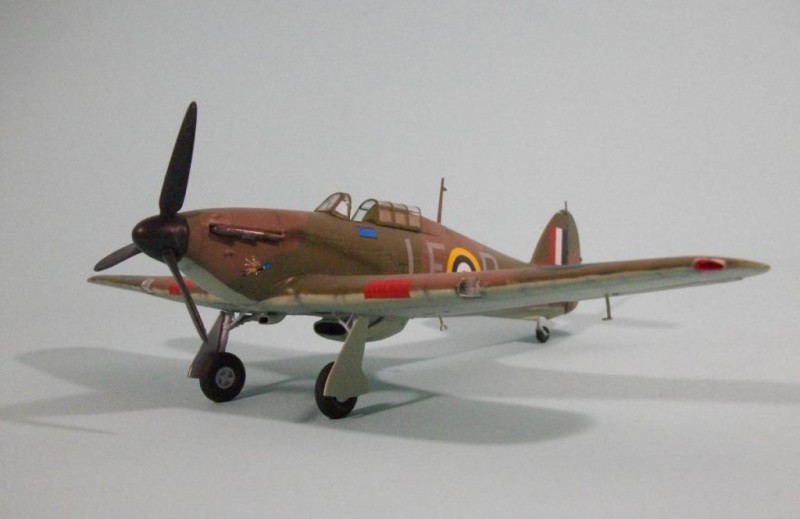
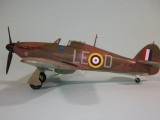
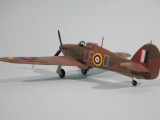
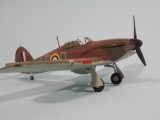
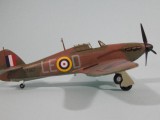
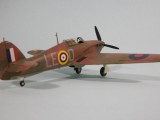
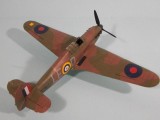
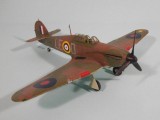
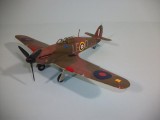
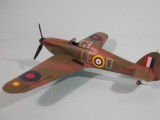
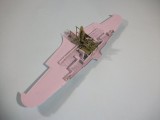
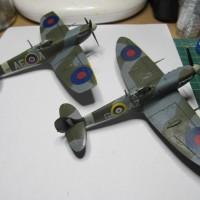
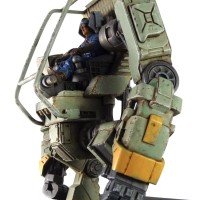
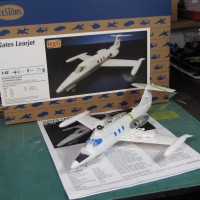
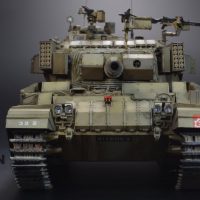
Nice Hurricane Tom - and thanks for the back-story on one of it's famous jockeys!
Smooth looking build Tom !
Very nice build on a famous aircraft, you did it justice, nice one Tom.
I'm amazed that so few companies have taken up the banner for a quality kit if this type. I accept that the aircraft is comparatively simple in some respects, but a quality larger-scale offering would still be welcome. The Airfix kits, though, are a welcome addition in quarter-scale.
Some people are Spitfire people and some are Hurricane people. I've always been the latter.
Nice bit of history. Thank you.
Build worked out nicely as well.
I've always thought that Hurricane was a Hawker Fury with a new wing and retractable landing gear.What TC didn't write about is that the Canvas fuselage having a tendency to burn along with the fuel tank directly in front of the cockpit. Many pilots got burn in the process and this is where the infancy of plastic surgery really started.
Bader definitely is a hero ...I agree with the article that his Big Wing theory was on the wrong side of history. I've always like modeling the Hurricane because, of its under dog status and I believe that during the Battle of Britain the pilots who made ace some of them just plain drove the a/c as close to target and blasted them from the sky. It didn't matter if you drove a Spit or Hurri. If you got close enough it didn't matter which a/c was the better or good enough.
Stanford Tuck ...now there's a interesting chap. Great bio and he and Bader can be seen on Youtube being interviewed in 76. https://www.youtube.com/watch?v=vDzZnCkbxgs
Two thumbs up for doing the usual stellar model and article TC.
Great looking Hurricane Mr Tom!

Greetings :
The HURRICANE ... one of my favorite aircraft. Brings memories just seeing it. I had the 1/32 scale REVELL model, I was maybe 12 years of age. It was by that model that I first used an air brush, and learned of Robert R. Stanford-Tuck ( the decals were for his markings ). I am still looking to get that model again. I am aware that there are better ones out there, but for sentimental feelings I want the REVELL model.
Good work on that model Tom, thanks for sharing those pictures. Hope to see this model in a TRIBUTE DISPLAY, it is very fitting.
I've still got my 1:72 Airfix Hurricane that I built in 1960 complete with hand painted camo and yellow tinged decals. Your model is excellent, what a great plane. (and a great backstory!)
I just love that Airfix have come back after decades of languishing on the brink of destruction, and are now setting standards for other manufacturers to emulate. Great job of what looks like a superb kit, Tom.
Looks great, the cockpit details are really nice.
Great model Tom! Always thought the old Airfix 1/48 Hurricane was a good kit shape and look wise, great to see they have now improved and brought out this gem. So good to see they even have got the subtle Hurricane wing dihedral right, Hurricane wing dihedral it was slight but it was there, basically a straight line to the wing upper surface, with the dihedral taper actually on the lower surface, often wrong on kits and definately requires a lot of work to fix on their excellent 1/24th scale kit. Yes your history is very interesting and bang on I think. Bader and the "Big Wing", good in theory but 11 Group were doing the right thing by harrying the German formations continuously albeit in small nymbers, as the crossed the coast, such a travesty when both Dowding and Keith Park basically got fired after the battle, despite having actually won it! In the brilliant written book on the career of Bob Tuck, Larry Forresters "Fly for Your Life" he tells the story how Sailor Malan and Bob Tuck had a blazing row with Bader in a Fighter Command office when they were asked if they wanted 20 mm cannon or continue with the 303 armament. Bader immediately just assumed to speak for them all and said they should continue with the 303's. Tuck flew into a rage at his arrogance and both he and Malan stated beyond doubt the 20mm cannon should be adopted as one cannon explosive shell strike was better than a whole belt of 303.
It's always amazing to me how wrong Bader was on just about everything tactical and strategic and technological. The one thing he got absolutely right was he was the first RAF flight leader to get rid of the Vic, the line-astern and all the other c**p, and adopt the finger-four. It constantly amazes me how much resistance there was in the RAF to the adoption of this formation - it didn't become standard over the line-astern until early 1944!
Some pilots are stick and rudder guys, but not always also tactically or technically astute, as well. Jim Thach and "Boots" Blesse spring to mind, Johnny Johnson. Not to take anything away from Bader, his big wing just took too long to get together.
You can depend on the enemy to do many things, but not necessarily what you want or expect.
You could also say that Bader didn't lack self confidence. Sometimes that can blind you to things.
Yeah Bernard, I must make it clear, I have the greatest admiration for Bader in what he overcame and achieved as a fighter pilot, you are quite right, he was a fearless leader and was able to boost the morale of his pilots with his confidence, which is something of value in combat, beyond measure. However he was so well regarded during and immediately after the war, that it is interesting to see the recent more holistic view of his character and wartime career coming to light. My boyhood hero was Bob Tuck, I think if he had an incredible career and had he not been shot down on the "Rhubarb" over France, he could well have become the leading allied ace, as he could shoot as well as Johnnie Johnson, on the other hand, being shot down may have saved his life? I would have loved to have met him, as Tom did. Yes Tom, agree, the finger four, adapted by Luftwaffe fighter pilots (Werner Molders) as far back as the Spanish civil war I think, a remarkably effective tactical formation, still used to this day, certainly with helicopter gunships and I'm sure with fighters.